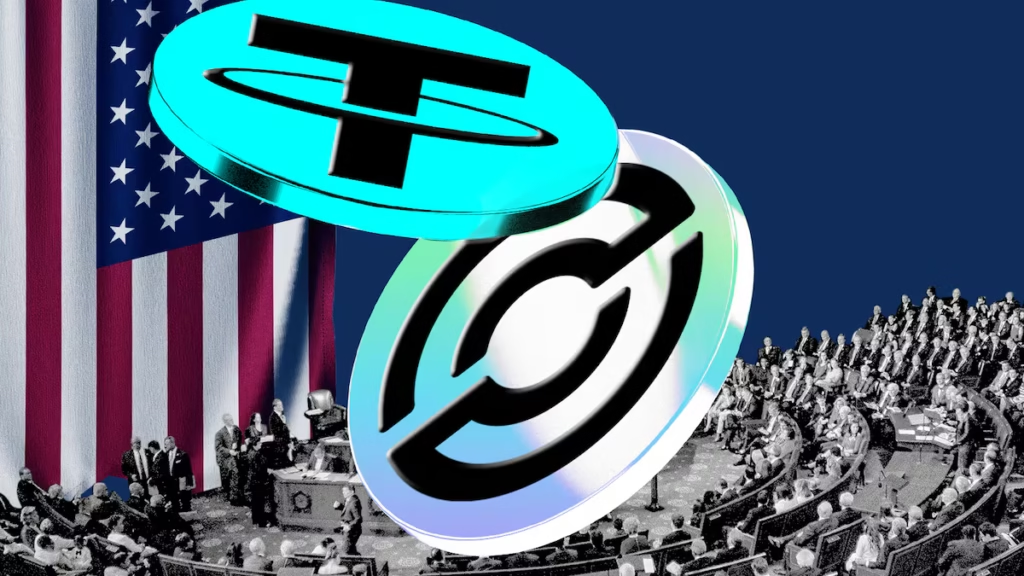What if the future of the U.S. dollar lives… on the blockchain?
Trump’s backing stablecoins. The Senate passed the GENIUS Act.
And behind the scenes? Crypto is buying up U.S. debt at a pace that’s catching the world’s attention.
This isn’t just about coins anymore — it’s about power, policy, and the comeback of the century.

Table of Contents
1. On April 15, Trump said he plans to sign an executive order supporting stablecoins—making it official.
2. He added, “I’ll foster legit dollar-backed stablecoins to protect the dollar’s worldwide strength.”

🔗 What’s a Stablecoin?
3. A stablecoin is a type of crypto that aims to keep its value steady.
4. Unlike Bitcoin, which zigs and zags in price, stablecoins are built to act more like everyday money.

5. They emerged to tame wild price swings and feel reliable like cash.
6. Some early coins nailed a 1:1 dollar peg—until the Terra‑Luna crash showed how fragile that setup was.
7. Terra‑Luna tried an algorithmic dollar peg without real reserves—and it failed spectacularly.
8. That failure gave rise to coins backed by actual dollars or U.S. Treasuries.
🏦 Tether vs Circle: The Big Stablecoin Stars

9. Today’s market is dominated by two big players: Tether and Circle.
10. U.S. regulators treat them very differently.
11. Tether’s based in the BVI, runs operations in Hong Kong, and has ties to Chinese tech—raising eyebrows.
12. Circle, on the other hand, has backing from big U.S. financial names and uses regulated U.S. banks.
13. It’s even moved its headquarters to New York and done an IPO.

📉 Bonds, Bucks & the Budget
14. The U.S. is projected to keep running $1 trillion-plus annual budget deficits for the next decade.
15. That means more Treasury bonds enter the market—pushing prices down and interest rates up.
16. But here’s where stablecoins come into play.
17. Tether promises 1 Tether equals $1, and you can redeem it anytime.

18. Redeeming means selling it back for a dollar, and where does that dollar go? Into Treasuries.
19. Since dollars don’t earn interest, the money usually heads into bonds.
20. So every Tether issued turns into new demand for U.S. debt.
21. That demand helps support bond prices—and that cools interest rates.
22. Sounds wild, but yes—a crypto coin can sway Treasury yields.

23. As of September 2024, Tether held about $102 billion in U.S. Treasuries.
24. That’s roughly the same as mid‑rank government holders like Germany or Brazil.
25. In other words, Tether handles bonds on par with a medium-size nation.
26. Meanwhile, China has been scaling back its Treasury holdings.
27. From $870 billion in 2022 down to $764 billion by September 2024.
28. That $106 billion reduction roughly matches Tether’s $102 billion stake.
29. In Q3 2024, Tether was even the third-largest buyer of new U.S. Treasuries.
30. Circle isn’t far behind—buying over $40 billion in bonds in 2024.
31. So as stablecoins buy bonds, Treasury prices stay steady—and interest rates stay lower.
32. That aligns with what Trump wants: lower 10-year Treasury rates.
33. Even if stablecoins aren’t perfect, they’re now key players in the bond market.

⚖️ GENIUS Act: Crypto Gets Congressional Love

34. Trump isn’t acting solo here.
35. In March 2025, the Senate Banking Committee approved the GENIUS Act—a stablecoin bill.
36. “GENIUS” stands for Guiding and Establishing National Innovation for U.S. Stablecoins Act.
37. But it’s also a clever name—like calling it “guardian genius.”

38. Americans love symbolic bill names.
39. The lawmakers behind it say it honors the “geniuses safeguarding U.S. financial strength.”
40. Officially, it’s a rules bill—but underneath, it’s about protecting the dollar and bond market.
41. The law brings stablecoins into the system with clear rules.
42. It defines who can issue coins and requires anti‑money laundering and KYC checks.
43. It guarantees coin-holders get paid first if the issuer goes bust.
44. It treats stablecoins as their own digital asset category—not stocks or insurance.
45. Most importantly, it forces a 1:1 reserve rule—funds must be backed by cash or Treasuries.
46. So the more coins get issued, the more Treasuries get bought.
47. They’ll mainly buy short-term bonds but can tweak long-term rates when needed.
48. On June 17, 2025, the Senate passed it 68–30.
49. Now it heads to the House—and Trump’s desk—soon.
50. Trump said he expects it on his desk “soon.”

🚀 Boosting the Dollar Abroad

51. Treasury Secretary Bessent praised the bill, calling it a global boost for the dollar.
52. He said the stablecoin market could grow to $3.7 trillion by 2030.
53. That adds a huge “VVIP” buyer to the Treasury side—on top of countries like China.
54. And it’s not just U.S.-centric.
55. Countries with weak currencies or costly remittance systems will likely adopt stablecoins fast.
56. That expands dollar influence—and the U.S. brand—around the world.
📈 Circle’s Big Moment

57. On June 5, Circle went public in New York under ticker CRCL—starting at $31.
58. Its stock has since rocketed toward $200—a major leap.
59. As of mid-June, it’s trading around $170–$190—an impressive rally.
60. With the GENIUS Act’s support, Circle is now a major financial influencer.
61. Its success shows how stablecoins are stepping into mainstream finance.
62. And the future? Stablecoins are now not just crypto talk—they’re global money players.

“One Coin, Two Wins: How the Dollar Just Got Smarter”

The GENIUS Act isn’t just a crypto law — it’s a double play.
On the surface, it helps protect the value of the U.S. dollar and Treasury bonds. But under the hood? It quietly expands the dollar’s reach across the globe, one stablecoin at a time.
Here’s the kicker: as more countries lean on dollar-backed stablecoins, they may face added complexity in managing their own currencies. That kind of dependence makes it easier for financial cracks — like currency crises — to slip through.
So while the U.S. is tightening its grip with smart strategy, other nations might be walking a fine line between convenience and control.
Discover more from Alphazen Dynamics
Subscribe to get the latest posts sent to your email.



